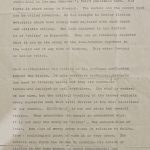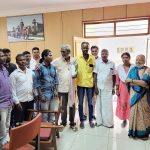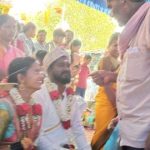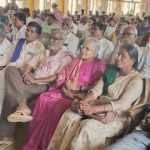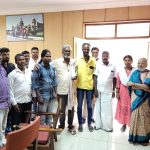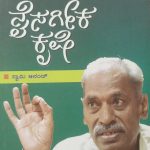“From those stubs, steel nibs are sprouting: new dalit writing from south India.
[This brief introduction to the life of Devanoora Mahadeva is taken from ananthology entitled: “From those stubs, steel nibs are sprouting: new dalit writing from south India. Dossier II Kannada and Telugu”, published in 2013 by Harper Collins Publishers, India and available at a cost of Rs 799. The texts in the volume were collected, translated and introduced by K. Satyanarayana and Susie Tharu. The volume contains English translations of excerpts from the work of 43 writers, documenting the raise of dalit writing in south India since the 1970s. The contributions are varried in style and each has a political message that challenges the status quo. ದೇವನೂರ ಮಹಾದೇವರ ಜೀವನಕ್ಕೆ ಸಂಬಂಧಿಸಿದ ಈ ಸಂಕ್ಷಿಪ್ತ ಪರಿಚಯವನ್ನು “From those stubs, steel nibs are sprouting: new dalit writing from south India. Dossier II Kannada and Telugu” ಸಂಕಲನದಿಂದ ತೆಗೆದುಕೊಳ್ಳಲಾಗಿದೆ: 2013 ರಲ್ಲಿ ಭಾರತದ ಹಾರ್ಪರ್ ಕಾಲಿನ್ಸ್ ಪಬ್ಲಿಷರ್ಸ್ನಿಂದ ಇದು ಪ್ರಕಟವಾಯಿತು ಮತ್ತು 799 ರೂಪಾಯಿಗಳಿಗೆ ಲಭ್ಯವಿದೆ. ಸಂಪುಟದಲ್ಲಿರುವ ಪಠ್ಯಗಳನ್ನು ಕೆ.ಸತ್ಯನಾರಾಯಣ ಮತ್ತು ಸೂಸಿ ತಾರೋ ಅವರು ಸಂಗ್ರಹಿಸಿ, ಅನುವಾದಿಸಿದ್ದಾರೆ ಮತ್ತು ಪರಿಚಯಿಸಿದ್ದಾರೆ. ಈ ಸಂಪುಟವು 43 ಲೇಖಕರ ಕೃತಿಗಳ ಆಯ್ದ ಭಾಗಗಳ ಇಂಗ್ಲಿಷ್ ಅನುವಾದಗಳನ್ನು ಒಳಗೊಂಡಿದೆ. 1970 ರ ದಶಕದಿಂದ ದಕ್ಷಿಣ ಭಾರತದಲ್ಲಿ ದಲಿತ ಬರವಣಿಗೆಯ ಬೆಳವಣಿಗೆಯನ್ನು ಇದು ದಾಖಲಿಸುತ್ತದೆ. ಇದರ ಕೊಡುಗೆಗಳು ವೈವಿಧ್ಯಮಯವಾಗಿವೆ ಮತ್ತು ಪ್ರತಿಯೊಂದೂ ಯಥಾಸ್ಥಿತಿಗೆ ಸವಾಲು ಹಾಕುವ ರಾಜಕೀಯ ಸಂದೇಶವನ್ನು ಹೊಂದಿದೆ.]
About the publisher:
Harper Collins Publishers
A-75, sector 57
NOIDA, UP
India
Phone: 0120-4044833, 4044858, 4044837
Sale enquiries: manisha.bhatia@harpercollins-india.commitali.garg@harpercollins-india.com Chapter 3, page 93-96]
Devanoora Mahadeva
‘I am not so active any longer. I do express my feelings in debates but only when it becomes inevitable. It is true that this often makes me an active participant. But these actions are always accompanied by immense conflict and unrest inside me. This intensity may be one reason why I write so little…’ Devanoora Mahadeva said during a discussion with us in his modest and beautiful Mysore home designed by the artist Shivaprakash. He was responding to our observation that he continues to be an influential presence in all the important Kannada debates.
‘Despite the intensity with which I get involved in things, my memory is poor, so I don’t usually tell life stories but since you ask, let me try,’ he continues. Mahadeva was ‘born on a Monday in 1948’ and spent the early years of his childhood in his mother’s village, Chikkakavlande, where he studied up to class three. ‘Even though I left this place so early and have few memories of it, the language of my writing is the language of this village,’ he points out.
When his father, a police constable, was transferred, the family moved to Hunsur, until 5 standard and later to Hampapura-Hommargalli, H D Kotetaluk, where Mahadeva continued his schooling and from there for few months to Devanoor and then to Saligrama for high school. As a young boy, he read the usual children’s magazines, like Gokula and Chandamama and several detective novels. He moved to Mysore for his PUC studies in science, and attended Yuvaraja College. He failed the science stream and moved to Maharaja College for his BA. Mahadeva wrote his first story in 1967, around the time he failed PUC. It is titled ‘KattalaThiruvu’, which can be translated as ‘twists ofdarkness’. He acknowledges that this storywas influenced, by BesagarahalliRamanna who also writes about the village life.
In high school, he joined an RSS unit, drawn by their ‘Hindu ondu’ (Hindus are one) slogan – an association that was to continue through his PUC years. ‘I joined, assuming there was equality but what I found was brahmin culture, stories and practices that create hatred towards Muslims, displeasure at inter-caste marriages and, overall, a philosophy of hatred. Later, I also came to be influenced by the socialist philosophy.’ Mahadeva left the RSS during his PU years and joined the socialist Samajvadi writer Su Ramakantha and inspired by the thinking of the celebrated peasants leader Nanjundaswamy and by the advocate and socialist T. N. Nagaraj. From 1973 onwards, while he was studying for his MA (which he completed in 1974), Mahadeva, along with Nanjundaswamy was active in building the socialist movement in tandem with the work Jayaprakash Narayan was doing in the north. They brought out the Lohiaite journal Manava. From 1975 to 1989, Mahadeva was a lecturer at the Central Institute of Indian Languages, Mysore. Bored by institutional life, he resigned the job in 1989 and took up farming.
Mahadeva’s writing career, on the other hand, remained a constant. His second story, ‘Marikondavaru’ (Those Who Sold themselves), written while he was PU student and published during his first year of under graduation days in Sankramana, a journal run by the playwright and poet Champa, made him something of a celebrity. He even received letters of appreciation adressed to ‘Devanoora Mahadeva, Professor of Kannada’. ‘The response was tremendous. It gave me confidence,’ he says with disarming simplicity. Around this time, he wrote three more stories. ‘It was a turning point for me,’ he says. ‘Dambaru Bandudu’ (Tar Comes) is his favourite story: ‘It’s one in which the formal structure and the writer’s handiwork is least obtrusive.’
The Navya movement was at its peak in the 1960s and ‘70s. Mahadeva was associated with all the major Navya writers, even though he distances himself from them. ‘Maybe there is a Navya sensibility in my writing but the outlook, approach, content are all different. Tejaswi’s Abachurina Post Offissu [the short story collection that marks the beginning of the Bandaya, or protest, literature movement in Karnataka may have been a more significant influence.’
The discussion turns to the question of village and writing about the village. Mahadeva speaks about the lack of a usable tradition of writing about the village and the sort of challenges it poses for writers. ‘The language from “Tar” onwards is my mother tongue, the language and sensibility of my mother’s village. But it is not simply a reproduction, there is a blending, a double presence, both in the language and the narration,’ he clarifies.
In 1973, while still an MA student, he wrote ‘Amasa’. The response to that came like a tidal wave. His classmates organized a seminar on the story and it was widely reviewed and discussed. It was not long before the story found its way into university syllabi in Karnataka and elsewhere. Despite the smallness of his oeuvre – just over a hundred pages at the time – Mahadeva was recognized as a major Kannada writer. With the publication of Kusumabale (the name of the novel’s female protagonist) in 1984, that position was consolidated. Odalala (Innards/The Heart of Hunger), a forty-page story that many regard as his masterpiece, and some as a classic of world literature, was completed in 1984. ‘The story has the feel of Vaikom Mohammed Basheer’s Pathumayude Adu’, Mahadeva says. G.S. Amur called it one of the ten best novels in Kannada. As of 2011, 30,000 copies of Kusumabale and 50,000 of Odalala have been sold. Mahadeva was elected president of the State BandayaSahityaSammelana in 1974. In 1989, Kusumabale received the Sahitya Akademi Award. In 1995, the Karnataka Sahitya Akademi honoured him for his achievements in literature.
Writing sets up a world, makes a picture for me. It speaks to me, touches me. It is not only cerebral. My writing is not a message for someone else; my reader is really only myself. While writing, I try to become the other being – writing about a stone, I try to become a stone and bring that into the picture. Writing is a lonely and somewhat subconscious phenomenon but it communicates, or so it seems! Is this a literature of the dality movement? I cannot say that with any confidence or certainty. Initially my readers were not dalits; today they are also dalits,’ he observes. His observations apart, it would not be wrong to say that his writing gave the dalit movement legitimacy in the mainstream literary world: ‘The manifestation of the pain and artistic energy of the dalits, together with his love for humanity and condcern for the orphaned downtrodden, has created a new idiom and a new sensibility in Kannada. Language becomes soft as wax, just as stone becomes a living medium in the hands of Hoysalascultptors,’ a commentator notes, adding, ‘Devanoora’s writings explore new possibilities of expression and expands the scope of Kannada narrative.’
The conversation moves seamlessly to political questions. Mahadeva tells us that, in 1974, ‘the socialist movement broke up into two streams: the farmer’s movement and the dalit movement. What formally became the Dalit SangharshSamiti (DSS) in 1976 included both the Ambedkarites, Lohiaites and Marxists. All writers, irrespective of their castes and irrespective of whether they were socialists, communists or Periyarites, supported the DSS. We had a strong bonding and the brotherhood was not disturbed by our differences. A kind of tolerance, understanding, wisdom was alive in the Karnataka movement at the time. In Hassan district, for example, different castes came together to take over government land and live there together. So many rare experiments took place in those days.’
Discussing the importance of Ambedkar within that political scene, he says, ‘the spirit of our admiration for Ambedkar is simple; an identity icon. But his writings are scholarly, legal, and difficult to read. What he stands for is a message. The writing is cerebral; his existence, its iconic value, is a matter of the heart. All those quarrels about caste or class are large, distant discussions about a simple question.’ And with that, he returns to his account of the 1970s and ‘80s: ‘There were also many debates. About boycotting elections for example. A few other activists and I did not believe that we should boycott elections; voting gives a movement a certain dynamism. The landless and women had no vote in many countries. They had to fight for it. Then there was the question of non-violence – and the question of dalits and the Congress. We took an anti-Congress stance during the Emergency. People finally accepted it, even if it was difficult to convince them. A third question arose with regard to support for the Janatha Party. The problem was that we did not have the maturity to handle politics. Today there are many aspiring leaders and many splits.’
Devanoora Mahadeva describes himself as ‘actively involved in early days in the socialist movement and for over three decades in the dalit movement in Karnataka’. He is president of Sarvodaya Karnataka, a political party that was formed through the union of the Karnataka Rajya Raita Sangha and dalit groups. For the past five years, the party has been trying to explore an alternative political system.
Susan Daniel, translator of the excerpts from Odalala and Kusumabale that we carry here, describes the former as ‘the story of Sakavva, the mother figure and head of a poor dalit household. Her faith in herself and her family in the face of exploitation and caste oppression sets her out as heroic. Writing about the Irish language, W.B. Yeats observed, “One has to find expression in it or exploit it.” Mahadeva seems to have done both with the Nanjangud dialect.” Kusumabale recreates in epic style the story of three generations. This poetic novel has at its centre the theme of an illicit affair between Kusuma, an upper-caste girl, with Chenna, a dalit boy. The birth of a child brings the relationship out into the open. While the village is readying for the annual fire-walking festival, Chenna’s relations fearfully await his return. Chenna is murdered. Alongside these events, Chenna’s relative Thooramma is struggling to bring to life her niece Eeary’s wasting child.’
The chapter on the ritual Eeary performs with Thooramma’s help, translated here, is a probing and deeply moving story of childhood starvation. ‘Tar Comes’, on the other hand, is an elemental account of Indian modernity as seen through the eyes of village dalits. Daniel describes the significance of Kusumabale thus: ‘This hauntingly poetic prose, layered with janapada [popular/people’s] traditions, echoes of world literature and the imaginative space of the everyday in a dalit’s life, leaves us with the amazing experience of being in the middle of an aesthetic tradition, which in reality is only now finding its voice.’
